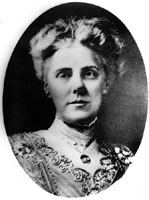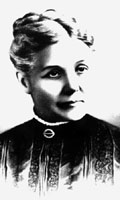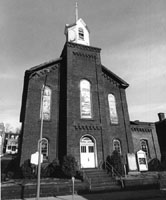|
But it
is Anna Jarvis of Philadelphia who is credited with
bringing about the official observance of Mother's Day.
Her campaign to establish such a holiday began as a
remembrance of her mother, who died in 1905 and who had,
in the late 19th century, tried to establish
"Mother's Friendship Days" as a way to heal
the scars of the Civil War.
Anna
was not quite 2 years old when her family moved to
Grafton, four miles south of Webster, W.Va. According to
historical records, Anna heard her mother express hope
that a memorial would be established for all mothers,
living and dead.
After
the death of her father in 1902, Anna --along with her
mother and sister, Lillie -- moved to Philadelphia to
reside with her brother, Claude. After Ann's death May
9, 1905, Anna began an intense campaign to fulfill the
wish of her mother.
On May
10, 1908, the third anniversary of Ann's death, a
program was held at Andrews Methodist Episcopal Church
in Grafton and in Philadelphia, launching the observance
of a general memorial day for all mothers.
Subsequently,
the church observed Mother's Day on the second Sunday of
May each year, making Andrews the mother church of
Mother's Day. The church, no longer an active Methodist
congregation, was incorporated as an international
shrine in 1962 and is open to the public from 9:30 a.m.
to 3:30 p.m. each weekday between April 15 and Oct. 15.
For the
first official Mother's Day service in 1908, Anna sent
500 white carnations to the church to be given to the
participating mothers. During the next several years,
she sent more than 10,000 carnations there. Carnations
–- red for the living and white for the deceased -–
became symbols of the purity, strength and endurance of
motherhood.
In her
campaign to have Mother's Day recognized as a national
holiday, Anna called on clergymen, business leaders and
politicians for help. Those included John Wanamaker, who
presided over a Mother's Day service in the 5,000-seat
auditorium of his Philadelphia store on May 10, 1908.
More than 15,000 reportedly tried to attend the event,
where Anna spoke for more than an hour.
The
first Mother's Day proclamation was issued by West
Virginia's governor in 1910. The day was celebrated in
most states in 1911.
In
1914, the U.S. House and Senate approved a resolution
proclaiming the second Sunday of May as Mother's Day.
President Woodrow Wilson endorsed it, and Secretary of
State William Jennings Bryan proclaimed it.
But
Jarvis' accomplishment soon turned bitter for her.
Enraged by the commercialization of the holiday, she
filed a lawsuit to stop a 1923 Mother's Day festival and
was even arrested for disturbing the peace at a war
mothers' convention where women sold white carnations -
Jarvis' symbol for mothers - to raise money. "This
is not what I intended," Jarvis said. "I
wanted it to be a day of sentiment, not profit."
When
she died in 1948 in a sanatorium in West Chester,
Pennsylvania at age 84, Jarvis had become a woman of
great ironies. Never a mother herself, her maternal
fortune dissipated by her efforts to stop the
commercialization of the holiday she had founded, Jarvis
told a reporter shortly before her death that she was
sorry she had ever started Mother's Day. She spoke these
words in a nursing home where every Mother's Day her
room had been filled with cards from all over the world.
On the day of the funeral, the bell on Andrews Church in
Grafton tolled 84 times in her honor.
The
home where Anna was born in the village of Webster,
W.Va., has been restored as a museum and is open for
visitors from 10 a.m. to 6 p.m., Tuesday through Sunday
and all holidays, March through December.
Today,
most of us celebrate Mother's Day with little awareness
of how it began. But we can identify with the respect,
love and honor that Anna Jarvis displayed nearly a
century ago. Women, especially mothers, face new
challenges in society today, but motherhood remains a
lasting influence on us as individuals and as a nation. |

MOTHER'S
DAY PROMOTER -- Anna Jarvis led a successful campaign in
the early 1900s to have Mother's Day recognized as a
national holiday. Anna had heard her mother, Ann Marie
Reeves Jarvis, wife of a Methodist pastor in West
Virginia, express hope that a memorial would be
established for all mothers, living and dead.

MOTHER
OF MOTHER'S DAY -- Ann Marie Reeves Jarvis, the wife of
a Methodist pastor in West Virginia, is recognized as
the "mother" of the Mother's Day holiday in
the United States. Her daughter led a successful
campaign in the early 1900s to have Mother's Day
recognized as a national holiday.

'MOTHER
CHURCH' -- Andrews Methodist Episcopal Church in
Grafton, W. Va., is recognized as the "mother
church" of Mother's Day in the United States.
|